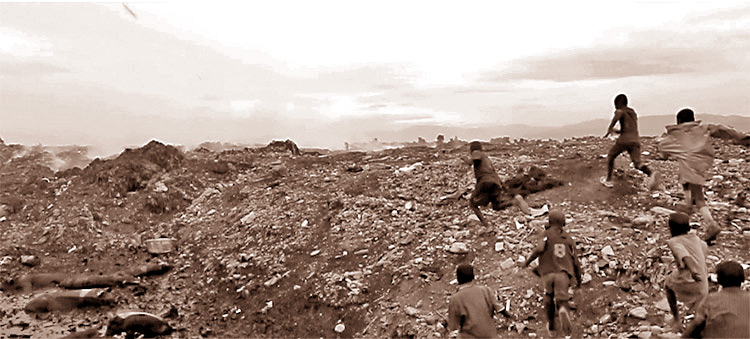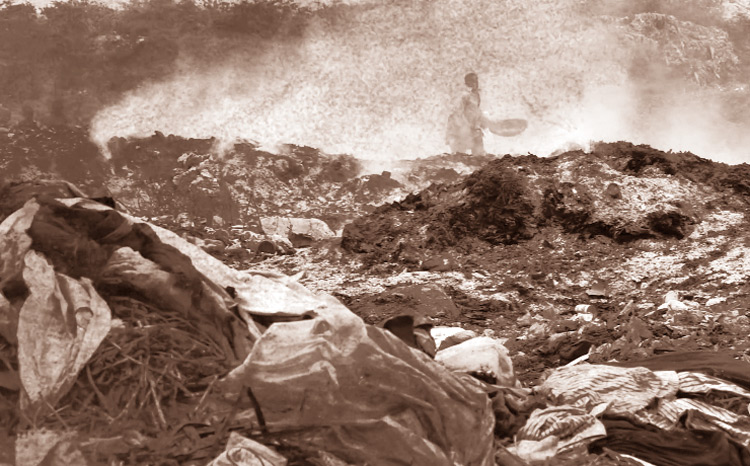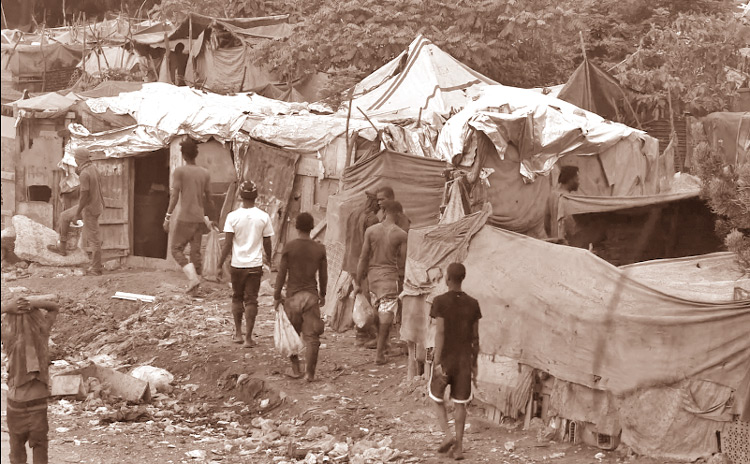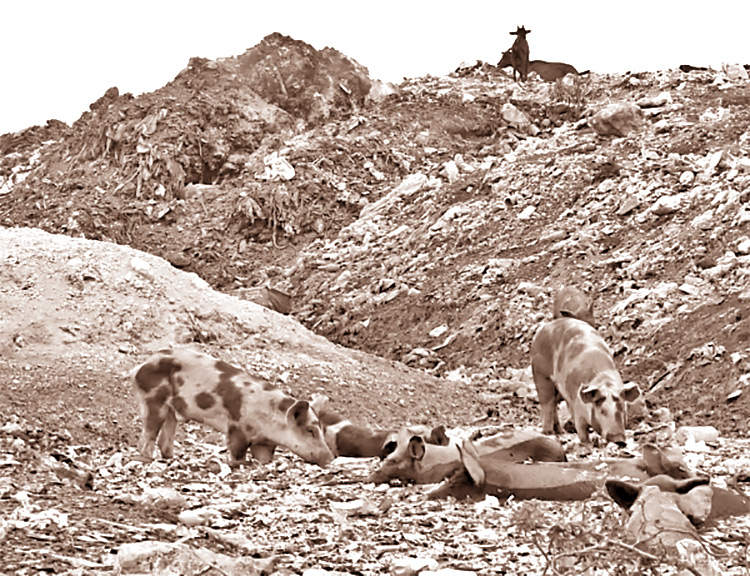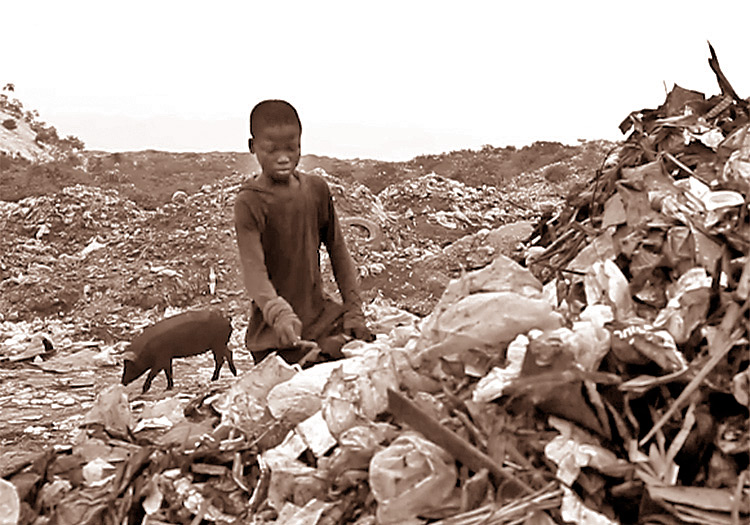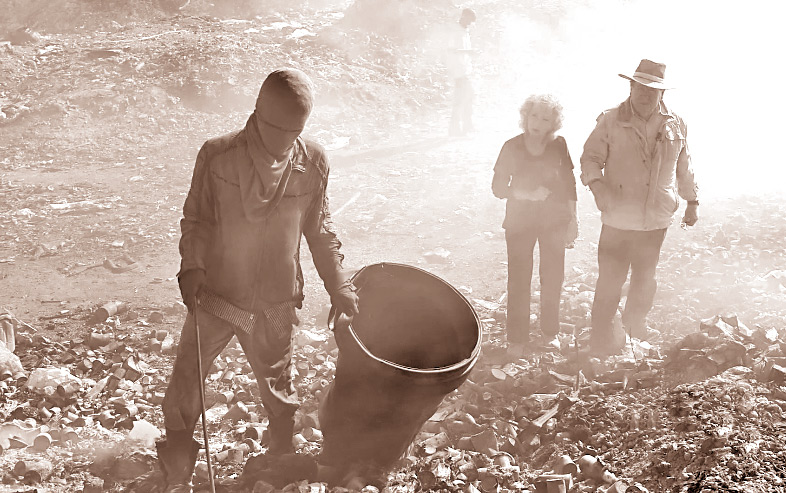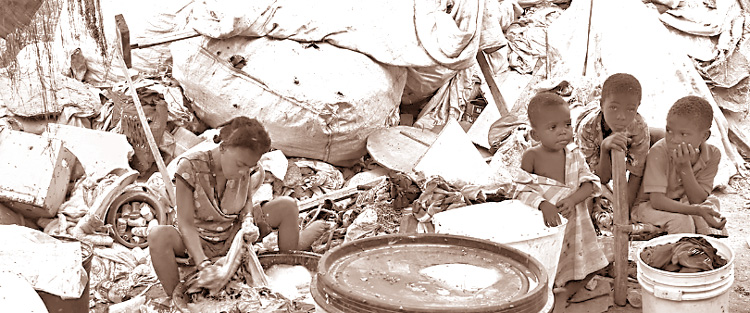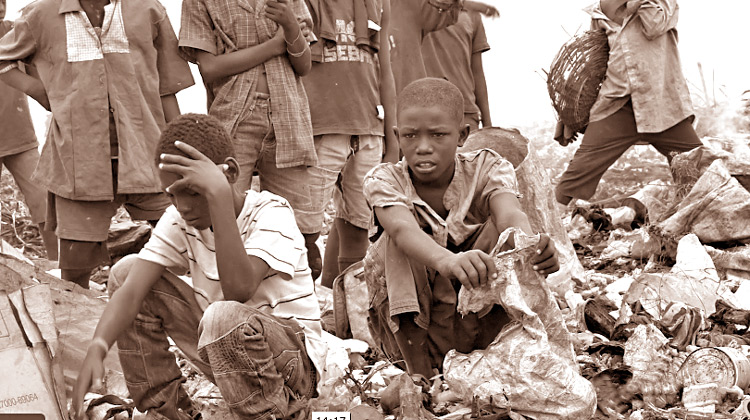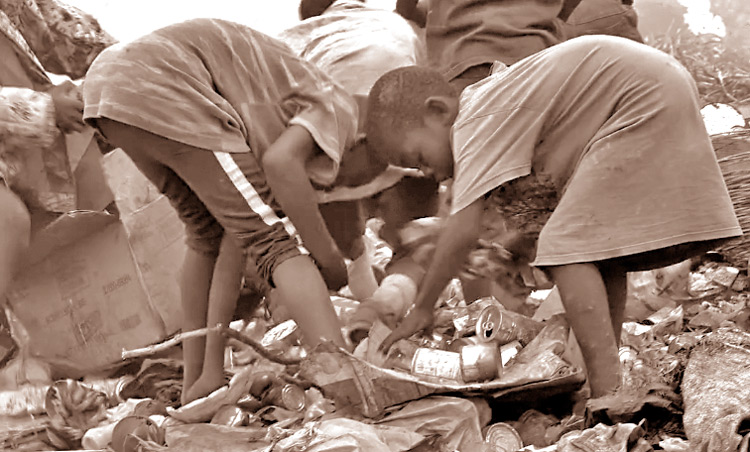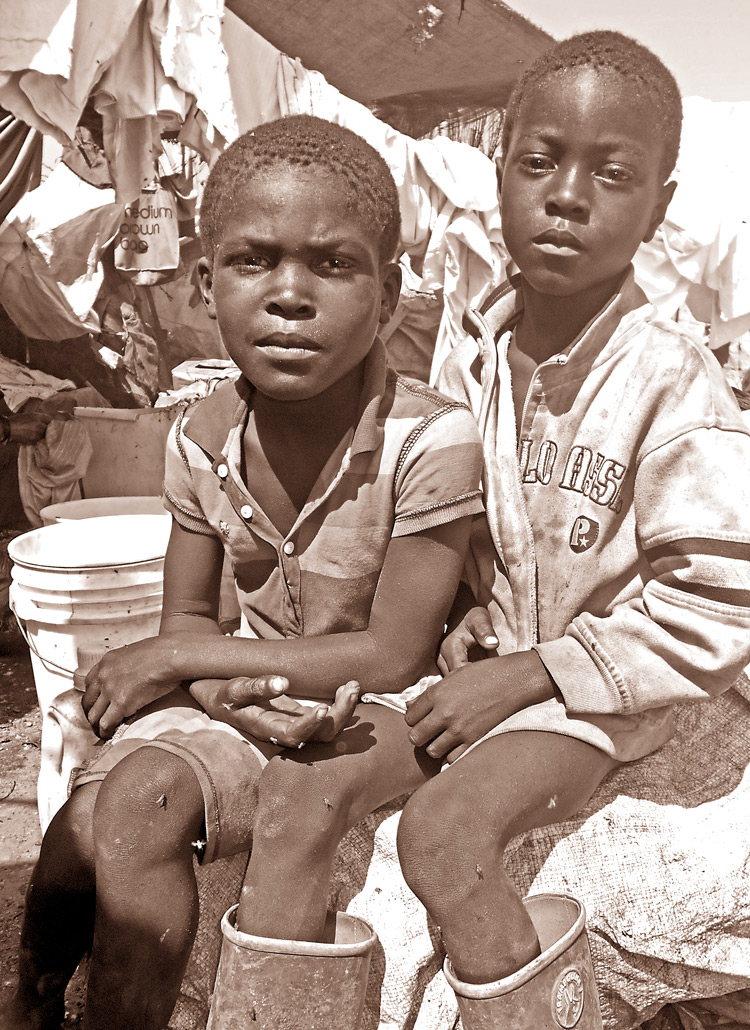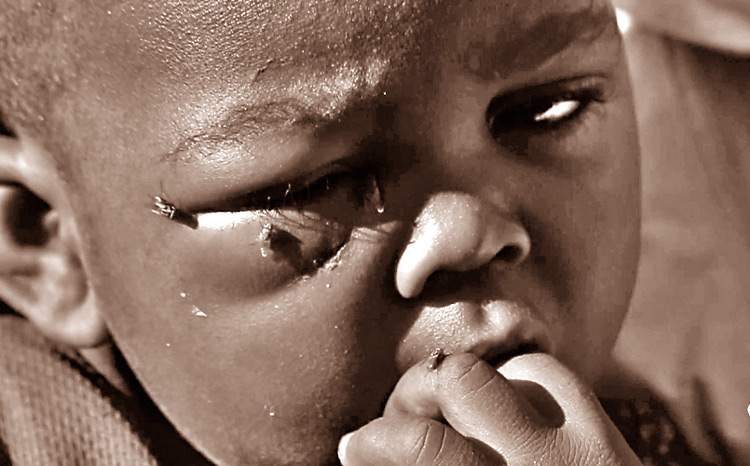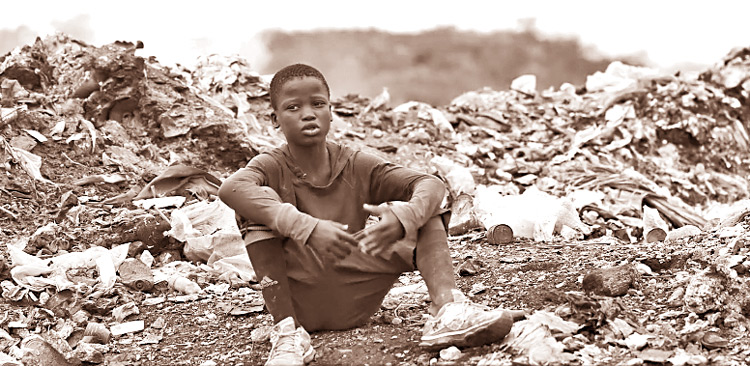II: THE PATH TO SUCCESSFUL RESOLUTION
This unprecedented plastic waste tide appears as vast as the ocean, as ungraspable as the unfathomable mass of microscopic plastic fragments present at sea, transported by winds and currents, yet, ultimately, the plastic tide can become as limited as our chosen relationship with plastics, which involves a dramatic behavioral change on our part. The path to successful resolution of the crisis clearly appears…as we are the problem and the solution.
THE VICTIMS AND THE AGGRESSORS
The despondent effects and too numerous casualties of the great plastic tide are visible, but more alarmingly, beyond visual, which ought to prompt the perpetrators to choose no other path than the advocacy and culture of consistent and sustained behavioral changes.

Creek in Manilla, Philippines, March 01 2009. Photo: Francis R. Malasig
THE VICTIMS
Animals
From the whale, sea lions, and birds to the microscopic organisms called zooplankton, plastic has been, and is, greatly affecting marine life, i.e animals on shore and off shore, whether by ingestion or entanglement.
In a 2006 report, Plastic Debris in the World’s Oceans, Greenpeace stated that at least 267 different species are known to have suffered from entanglement and ingestion of plastic debris. The National Oceanographic and Atmospheric Administration said that plastic debris kills an estimated 100,000 marine mammals annually, millions of birds and fishes.
The largest pieces of marine plastic debris, miles long discarded fishing nets and lines mostly, take an obvious toll on animals. These derelicts nets, called ghost nets, snare and drown thousands of larger sea creatures per year, such as seals, sea lions, dolphins, sea turtles, sharks, dugons, crocodiles, seabirds, crabs, and other creatures. Acting as designed, these nets restrict movement causing starvation, laceration, infection, and, in animals that need to return to the surface to breathe, suffocation.

Entangled seal by derelict net, Hawaii. Photo Source: NOAA
On shores, researchers have also watched in horror as hungry turtles wolf down jellyfish-like plastic bags and seabirds mistake old lighters and toothbrushes for fish, choking when they try to regurgitate the plastic trash for their starving chicks.

Turtle eats plastic. Photo Source: Greenhouse Carbon Neutral Fdn
In the waters, plastic bags specifically, can be mistaken as food and consumed by a wide range of marine species, especially those that consume jellyfish or squid, which look similar when floating in the water column.
Albatross and others birds are choosing plastic pieces because of their similarity to their own food as well. Captain Moore and his Alguita team did see, above the GGP, albatrosses and tropicbirds circling above the line of trash. With little else to choose, they were obviously eating plastic. The birds seemed to be picking and choosing “the reds and pinks and browns. Anything that looks like shrimp,” Moore says. Earlier in the trip, the Alguita had visited the French Frigate Shoals, off Hawaii, home to endangered monk seals and seabird rookeries. In the birds’ gullets researchers found red plastic particles. Greenpeace reported that a staggering 80 percent of seabird populations observed worldwide have ingested plastics. Research into the stomach contents of dead Fulmars from the Netherlands, between 1982 and 2001, found that 96 percent of the birds had plastic fragments in their stomachs with an average of 23 plastic pieces per bird (Van Franeker and Meijboom, 2003).

Midway atoll, bird corpse. Photo: © Chris Jordan
When plastic ingestion occurs, it blocks the digestive tract, gets lodged in animals windpipes cutting airflow causing suffocation, or fills the stomach, resulting in malnutrition, starvation and potentially death. Indeed, it is found that debris often accumulates in the animals’ gut and give a false sense of fullness, causing the animal to stop eating and slowly starve to death.

Midway atoll, bird corpse. Photo: © Chris Jordan
In April 2002 a dead Minke whale washed up on the Normandy coast in France. An investigation found that its stomach contained 800 kg of plastic bags (GECC, Groupe d’Etude des Cétacés du Cotentin, 2002).
In February 2004, a Cuviers Beaked whale (Ziphius cavirostris) was found washed ashore on the west coast of the Isle of Mull, Scotland. Cuviers beaked whales are rarely seen in coastal waters, as they are predominantly a deep-water species. The Hebridean Whale and Dolphin Trust took various skin and blubber samples and removed the stomach for further study by the Scottish Agricultural College. On initial removal it was found that the entrance to the stomach was completely blocked with a cylinder of tightly packed shredded black plastic bin liner bags and fishing twine. It is believed that this made it difficult for the animal to forage and feed effectively.
50 to 80 percent of sea turtles found dead are known to have ingested plastic marine debris.
The smaller the pieces of plastic get, the more dangerous they are to marine organisms. Fragmented plastic, specifically nurdles and small size mermaid tears, are found in the stomach of smaller sea creatures as well: fish, birds, marine mammal, reptile, jelly fish, select plastic pellets as they resemble fish eggs.
Whether the chemicals contained in the plastics are then desorbed to digestive fluids and transferred to tissues in quantities significant enough to harm the animals is subject to ongoing, yet still incomplete, research. However, as more and more studies on the matter are undergone, unpleasant findings are definitly uncovered.
What is proven, as we’ve seen supra, is that plastic does soak up pollutants, acting as toxic-sponge for man-made toxins present in the ocean, thus accumulating pollutants such as polychlorinated biphenyls (PCBs) and heavy metals at concentrations up to 1 million times higher than in ocean water (Moore et al, 2001). PCBs can lead to reproductive disorders, death, an increased risk of disease, and an alteration of hormone levels (Ryan et al., 1988;Lee et al, 2001). They have been linked to the masculinisation of female polar bears and spontaneous abortions and declines in seal populations. In 1988, Ryan et al obtained evidence that PCBs in the tissues of Great Shearwaters were derived from ingested plastic particles (from Derraik, 2002). Furthermore, DDT, a pesticide that was banned in the US in the 1960’s and labeled by the Environmental Protection Agency in 1987 as a “probable human carcinogen,” has been found on these plastics fragments. The most recent review of all evidence concludes that exposure to DDT before puberty increases the risk of breast cancer.
Food Chain
In a September press conference, Doug Woodring from Project Kaisei, said that assessments of the impact of plastic debris on phytoplankton, zooplankton, and mesopelagic (midwater) fishes are undergoing. The samples collected from the seawater will be subject to more scientific studies for the toxicity of the plastics and how this is really affecting our food chain (in ways that are only just becoming known… and not good ways).

Plastic found in Rainbow Runner fish guts. Photo Source: Algalita Marine Research Foundation
Katsuhiko Saido, Ph.D said, “We found that plastic in the ocean actually decomposes (…) giving rise to yet another source of global contamination that will continue into the future.” Furthermore, as Saido added: “We are concerned that plastic pollution is also caused by these invisible materials and that it will harm marine life.” While the potential toxicity of these tiny plastic constituents is still understudied for much of marine life, plastics are abundant in many forms. Plastics, including polystyrene, are common in the wads of accumulated, undigested matter that young black-footed albatrosses cough up before they fledge.
Whether plastics present a unanimously accepted and proven toxic challenge to marine life, and subsequently to humans, is one of the biggest challenges facing scientists right now.
Health
Saido’s latest science report last summer about the decomposition of polystyrene plastics vests a simple reality: Bisphenol A (BPA) has been shown and proven to interfere with the reproductive systems of animals. PS oligomer and BPA from plastic decomposition are toxic and can be metabolized, while styrene monomer is a suspected carcinogen. Low levels of BPA and PS oligomer have been proven to cause hormone disruption in animals.
More scientific reports are being published on the effects of Bisphenol A on animal and human health, and the news is not good.
In 2009, a professional, international medical organization in the field of endocrinology and metabolism, The Endocrine Society, reported data from new research on animals experimentally treated with BPA. Studies presented at the group’s annual meeting show BPA can affect the hearts of women, can permanently damage the DNA of mice, and appear to be entering the human body from a variety of unknown sources. A 2005 study, which analyzed BPA serum concentrations, concluded that “exposure to BPA is associated with recurrent miscarriage”.
The first major study of health effects on humans associated with bisphenol A exposure was published in September 2008 by Iain Lang and colleagues in the Journal of American Association. The cross-sectional study of almost 1,500 people assessed exposure to bisphenol A by looking at levels of the chemical in urine. The authors found that higher bisphenol A levels were significantly associated with heart diseases, diabetes, and abnormally high levels of certain liver enzymes.
A 2008 scientific review concluded that “prenatal exposure to (…) low doses of BPA alters breast development and increases breast cancer risk”. A 2009 scientific review, funded by the “Breast Cancer Fund”, has recommended “a federal ban on the manufacture, distribution and sale of consumer products containing bisphenol A”.
A 2009 study on urinary concentrations concluded that prenatal BPA exposure might be associated with externalizing behaviors in two-year old children, especially among female children.
A 2009 study on Chinese workers in BPA factories found that workers were four times more likely to report erectile dysfunction, reduced sexual desire, and overall dissatisfaction with their sex life than workers in factories that made products ranging from textiles to machinery, in which there was no heightened BPA exposure. They were also more likely to report reduced sexual function within one year of beginning employment at the factory, and the higher the exposure, the more likely they were to have sexual difficulties.
A 2009 review of available studies has concluded, “Prenatal BPA exposure acts to exert persistent effects on body weight and adiposity.”
A 2009 scientific review about environmental chemicals and thyroid function concluded, “Available evidence suggests that governing agencies need to regulate the use of thyroid-disrupting chemicals, particularly as such uses relate exposures of pregnant women, neonates and small children to the agents”. A 2009 review summarized BPA adverse effects on thyroid hormone action.

Kuta beach, Bali. Photo Source: Claude Graves
All sea creatures, from the largest to the microscopic organisms are, at one point or another, swallowing the seawater soup instilled with toxic chemicals from plastic decomposition. Much of ocean’s life is in the microscopic size range and zooplankton is the base of the food chain. As environmentalists remind the world’s population, “…We are eating fish that have eaten other fish, which have eaten toxin-saturated plastics. In essence, humans are eating their own waste…” (Dixit Renee Brown, WiredPress).”
Beaches, Coast, Sea Floor, Shorelines
Blatantly visible is the plastic spill washing up on the shores and beaches. Just a walk on any beach, anywhere in the world, and plastic debris are found in one form or another. All over the world the statistics are ever growing, just staggeringly. Last year, an estimated 150,000 tons of marine plastic debris washed up onto the shores of Japan and 300 tons a day on India’s shores.

Layson Island, Hawaiian islands. Photo Source: NOAA
The Hawaiian Archipelago, extending from the southernmost island of Hawaii 1,500 miles northwest to Kure Atoll, is among the longest and most remote island chains in the world. The 19 islands of the archipelago, including Midway atolls, receive massive quantities of plastic debris, shot out from the Pacific gyres. Some of the plastic litter is decades old. Some beaches are buried under 5 to 10 feet of plastic trash, while other beaches are riddled with “plastic sand,” millions of grain-like pieces of plastic that are practically impossible to clean up. One of the reasons marine debris accumulates in these islands is the movement of debris within the North Pacific Subtropical Convergence Zone (STCZ), as we have explained supra.
Two studies on several islands off Jakarta Bay and islands further to the northwest in the Java Sea, reported that debris pollution on shorelines had substantially increased between 1985 and 1995 (Uneputty and Evans 1997b, Willoughby et al. 1997). Both studies noted that results implicated Jakarta as a major source of the debris. On 23 of the islands, it was reported that the total litter at the strandline ranged from not detectable to 29.1 items/m (Willoughby et al. 1997). Plastic bags, polystyrene blocks, and discarded footwear accounted for 80 percent of the items found.
Researchers Barnes and Milner (2005) list five studies which have shown increases in accumulation rates of debris on mid to high latitude coasts of the southern hemisphere.
Surveys of shorelines around the world, reported by Greenpeace, have recorded the quantity of marine debris either as the number of items per km of shoreline or the number of items per square meter of shoreline. The highest values reported were for Indonesia (up to 29.1 items per m) and Sicily (up to 231 items per m).

Seabed Pollution. Photo Source: Bouteilles à la mer org.
It’s been reported by Greenpeace that an estimated 70 percent of the mass of fragmented plastic present in the open oceans of the world does sink to the deep-sea bed. A limited body of literature exists, though, concerning these small to microscopic particles (micro debris) mirroring the little research addressed to marine litter on the sea floor.
Ecosystem Changes
Another effect of the plastic tide that goes beyond visual is its potentiality to change entire ecosystems.
“Plastic is not just an aesthetic problem,” says marine biologist David Barnes of the British Antarctic Survey. “It can actually change entire ecosystems.” He has documented that plastic debris which floats on the oceans, acts as rafts for small sea creatures to grow and travel on. This represents a potential threat for the marine environment should an alien species become established. It is postulated that the slow speed at which plastic debris crosses oceans makes it an ideal vehicle for this. The organisms have plenty of time to adapt to different water and climatic conditions.
Coral Reefs
Derelict fishing gear can be destructive to coral reefs. Corals are in fact animals, even though they may exhibit some of the characteristics of plants and are often mistaken for rocks. In scientific classification, corals fall under the phylum Cnidaria and the class Anthozoa. They are relatives of jellyfish and anemones. (NOAA)
Nets and lines become snagged on coral and subsequent wave action causes coral heads to break off at points where the debris was attached. Once freed, debris can again snag on more coral and the whole process is repeated. This cycle continues until the debris is removed or becomes weighted down with enough broken coral to sink (NOAA 2005a). Eventually, derelict fishing gear may become incorporated into the reef structure.

Plastic on Coral. Photo Source: EPA
Plastic bags can kill coral by covering and suffocating them, or by blocking sunlight needed by the coral to survive. During 2001, so many plastic bags were regularly seen in the Gulf of Aqaba, off the coast of Jordan, that the Board of Aqaba Special Economic Zone issued a law banning the production, distribution, and trade of plastic bags within the areas under their jurisdiction.
Economics
Marine litter cause serious economic losses to various sectors and authorities. Among the most seriously affected are coastal communities (increased expenditures for beach cleaning, public health and waste disposal), tourism (loss of income, bad publicity), shipping (costs associated with fouled propellers, damaged engines, litter removal and waste management in harbors), fishing (reduced and lost catch, damaged nets and other fishing gear, fouled propellers, contamination), fish farming and coastal agriculture.

Haina, Dominican Republic. Photo Source: Eduardo Munoz
In a 2007 Fortune Magazine article about India, it was written that the costs of river pollution to the economy are enormous. Waterborne diseases are India’s leading cause of childhood mortality. Shreekant Gupta, a professor at the Delhi School of Economics who specializes in the environment, estimates that lost productivity from death and disease resulting from river pollution and other environmental damage is equivalent to about 4 percent of gross domestic product.
The bill for cleaning the beaches in Bohuslän, on the west coast of Sweden, in just one year was reportedly at least 10 million SEK or $1,550,200. In Britain, Shetland fishermen reported that 92 per cent of them had recurring problems with debris in nets, with each boat losing between $10,500 and $53,300 per year as a result of marine litter. The cost to the local industry could be as high as $4,300,000. The municipality of Ventanillas in Peru has calculated that it would have to invest around $400,000 a year in order to clean its coastline, while its annual budget for cleaning all public areas is only half that amount. (Unep)
Our Oceans and coastlines are under unprecedented plastics waste attack. It’s coming back at us in many ways. It’s a dire problem that only received serious scientific and public attention in the early 90’s, as we know, but all along the perpetrators have simply and clearly been identified.
THE AGGRESSORS
The obvious and simple answer is: us…
Behind each and every piece of littered plastic debris there is a human face. At a critical decision point, someone, somewhere, mishandled it, either thoughtlessly or deliberately. Cigarette filters and cigar tips, fishing line, rope and gear, baby diapers and nappies, six-pack rings, beverage bottles and cans, disposable syringes, tires, the litany of plastic litter is as varied as the products available in the global marketplace, but it all shares a common origin.
Sources
260 million tons per year is our estimated plastic consumption, 6 789 billion, is the estimated world population (United States Census Bureau, as of October 2009). Our voracious appetite for plastics, coupled with a culture of discarding products that we have chosen for their inherent longevity, is a combination of lethal nature for our environment.

Plastic Sea. Photo Source: Coastal wiki
The ultimate symbol of our throwaway lifestyle is the plastic bag: 500 billion to 1 trillion plastic bags is the number consumed annually, which is about a million a minute. The production of plastic bags creates enough solid waste per year to fill the Empire State Building two and a half times. The petroleum used to make only 14 plastic bags could drive a car 1 mile.
Plastic bags are commonly found in waterways, on beaches, and in other unofficial dumping sites across China, for instance. Litter caused by the notorious bags has been referred to as “white pollution.”
In the United States, however, measures to ban or curtail the use of plastic bags have met with official resistance. With its powerful lobby, the plastics industry argues that jobs will disappear. The industry employs some two million workers. Americans alone throw out at least 100 billion bags a year, the equivalent of throwing away 12 million gallons of oil, which seems an intolerable waste. Until the U.S. follows the lead of San Francisco, China, Ireland, Uganda, South Africa, Russia, and Hong Kong and targets the reduction of plastic bags using legislature, we each need to make a conscious choice and refuse to use it.
The core of the plastic waste instillation in world’s oceans is primarily rooted in poor practices of solid waste management, a lack of infrastructure, various human activities, an inadequate understanding on the part of the public of the potential consequences of their actions, the lack of adequate legal and enforcement systems nationally and internationally, and a lack of financial resources affected to the cause. Mainly a consensus needs to happen, as a culture of behavioral changes needs to be promoted.
The four main land-sources of plastics debris have been identified as:
-
Shoreline And Recreational Activities Related Litter
This includes: bags, balloons, beverages bottles, cans, caps, lids, shoes, cups, plates, forks, knives, spoons, food wrappers/containers, six-pack holders, pull tabs, shotgun shells/wadding, straws, stirrers, toys, medical hygiene (condom, syringe), drug and smoking paraphernalia (The filters are made of cellulose acetate, a synthetic polymer (fiber) that can last for many years in the environment), and 55 gallons drums. All this land-based debris blows, washes, or is discharged into the water from land areas after people engaged in beach-going activities have discarded it.

Branscombe, United Kingdom, Photo: Matt CardyAbout 80 percent of all tourist flock to coastal areas. Massive influxes of tourists, often to a relatively small area, have a huge impact, adding to the pollution of the local population, putting local infrastructure and habitats under enormous pressure. For example, 85 percent of the 1.8 million people who visit Australia’s Great Barrier Reef are concentrated in two small areas, Cairns and the Whitsunday Islands, which together have a human population of just 130,000 or so, WWF reported.
Shoreline activities account for 58 percent of the marine litter in the Baltic Sea region and almost half in Japan and the Republic of Korea. In Jordan, recreational activities contribute up to 67 percent of the total discharge of marine litter. This is a particularly big problem in the East Asian Seas region – home to 1.8 billion people, 60 percent of whom live in coastal areas – with its fast growing shipping and industrial development. Other emerging hotspots include the oil-boom coasts of the Caspian and the littoral states of Iran and Azerbaijan.
In South Asia, the growing ship-breaking industry has become a major source of marine debris. In Gujarat, India – one of the largest and busiest ship-breaking yards in the world – operations are carried out on a 10-kilometer stretch on the beaches of Alang, generating peeled-off paint chips and other types of non-degradable solid waste making its way into the sea.
-
Sewage (Waste Waters Containing Plastic Type Products, Rivers, Waterways)
Under normal, dry weather conditions, most wastes are screened out of sewage in countries that do apply strict sewage treatment. However, materials can bypass treatment systems and enter waterways when rain levels exceed sewage treatment facilities’ handling capacity. During these times, sewage overflows occur.
The Yamuna River, which flows 855 miles from the Himalayas into the Ganges, is one of India’s most, but not only, polluted river. The Centre for Science and Environment says that nearly 80 percent of the river’s pollution is the result of sewage. Combined with industrial runoff, that comes to more than three billion liters of waste per day, a quantity well beyond the river’s assimilative capacity. Many Indian rivers are so polluted they exceed permissible levels for safe bathing.

Yamuna River in New Delhi. Photo: Manan VastsyayanaIt has been reported that the lack of adequate solid waste management facilities results in hazardous wastes entering the waters of the Western Indian Ocean, South Asian Seas, and southern Black Sea, among others.
-
Fishing Related Debris
Dumping, wastes from ships, boats platforms (20%). Derraik (2002) stated that ships are estimated to dump 6.5 million tons of plastic a year. An estimated fourth fifths of the oceanic debris is litter blown seaward from landfills and urban runoff washed down storm drains. (Unep). Clean up on land where 80 percent of the plastic debris originates is thus the primarily obvious answer.
Manual Clean Up
The simplest, yet highly effective, action is the manual clean up of the beaches, coasts, rivers, lands and estuaries.
National and international manual clean-up operations of shorelines and sea floor are in existence.
For instance, the past 20 years, the Japan Environmental Action Network (JEAN) has been organizing a yearly beach cleanup and survey.
On an international level, the International Coastal Cleanup (ICC) was installed. The International Coastal Cleanup (ICC) engages the public to remove trash and debris from the world’s beaches and waterways, to identify the sources of debris, and to change the behaviors that cause pollution. The origins of the ICC began in 1985 with research conducted by The Ocean Conservancy (then known as the Center for Marine Conservation – CMC) on plastics in the marine environment. Contracted by the U.S. Environmental Protection Agency, Office of Toxic Substances, the CMC produced the report Plastics in the Ocean: More Than a Litter Problem, which was the first study to identify plastics as a significant marine debris hazard. The data collected and analyzed from the annual ICC Cleanup is used locally, nationally and internationally to influence policy decisions, spawn campaigns for recycling programs, support public education programs, launch adopt-a-beach programs, and even storm water system overhaul and legislative reform.
The Clean Up the World program is run in conjunction with UNEP. It engages more than 40 million people from 120 different countries in clean up operations.

Hawaiin shores. Photo Source: epa.gov
As part of its Rise Above Plastics campaign, Surfrider foundation is hosting frequent beach clean-ups; it is an example of an encouraging trend towards collective awareness and action to solve the problem at its source.
Worldwide private groups and associations are more and more aware that clean-up does need to happen, one day at a time, one person at a time.
Cleaning Up Of The Oceans Debris In The Open Seas
NOAA has also been contacted regarding cleanup of the debris directly in the garbage patch and other areas of the North Pacific; however, cleanup is likely to be more difficult than it may seem. “If only things were that simple. We could just go out there and scoop up an island,” says Holly Bamford, director of NOAA’s marine debris program. “If it was one big mass, it would make our jobs a whole lot easier.” It’s like a galaxy of garbage, populated by billions of smaller trash islands that may be hidden underwater or spread out over many miles.
Furthermore, in some areas where marine debris concentrates so does marine life, such as in the STCZ. This makes simple scooping up of the material risky, more harm than good may be caused. Straining ocean waters for plastics would capture the plankton that is the base of the marine food web and responsible for 50 percent of the photosynthesis on Earth. (NOAA).
As Captain Charles Moore once said: the cleaning up effort of the oceanic garbage patches “would bankrupt any country and kill wildlife in the nets as it went.”
However, confident in the future and investigating new horizons, Doug Woodring, from Project Kaisei, will be producing a documentary for National Geographic testing catch techniques for the plastic waste (“we know not all can be caught, but some can for sure”), at least for the largest debris that we know do decompose over time and actually more rapidly than previously thought.

Marine debris accumulation, on seafloor. Photo Source: NOAA
The clean up operation is the most immediate, highly effective, and simplest, action/plan that we, the problem, can undertake right now to contribute to the solution. It is a great starting point for a fundamental cultural change that need to occur, which is part of a major consensus.
David























